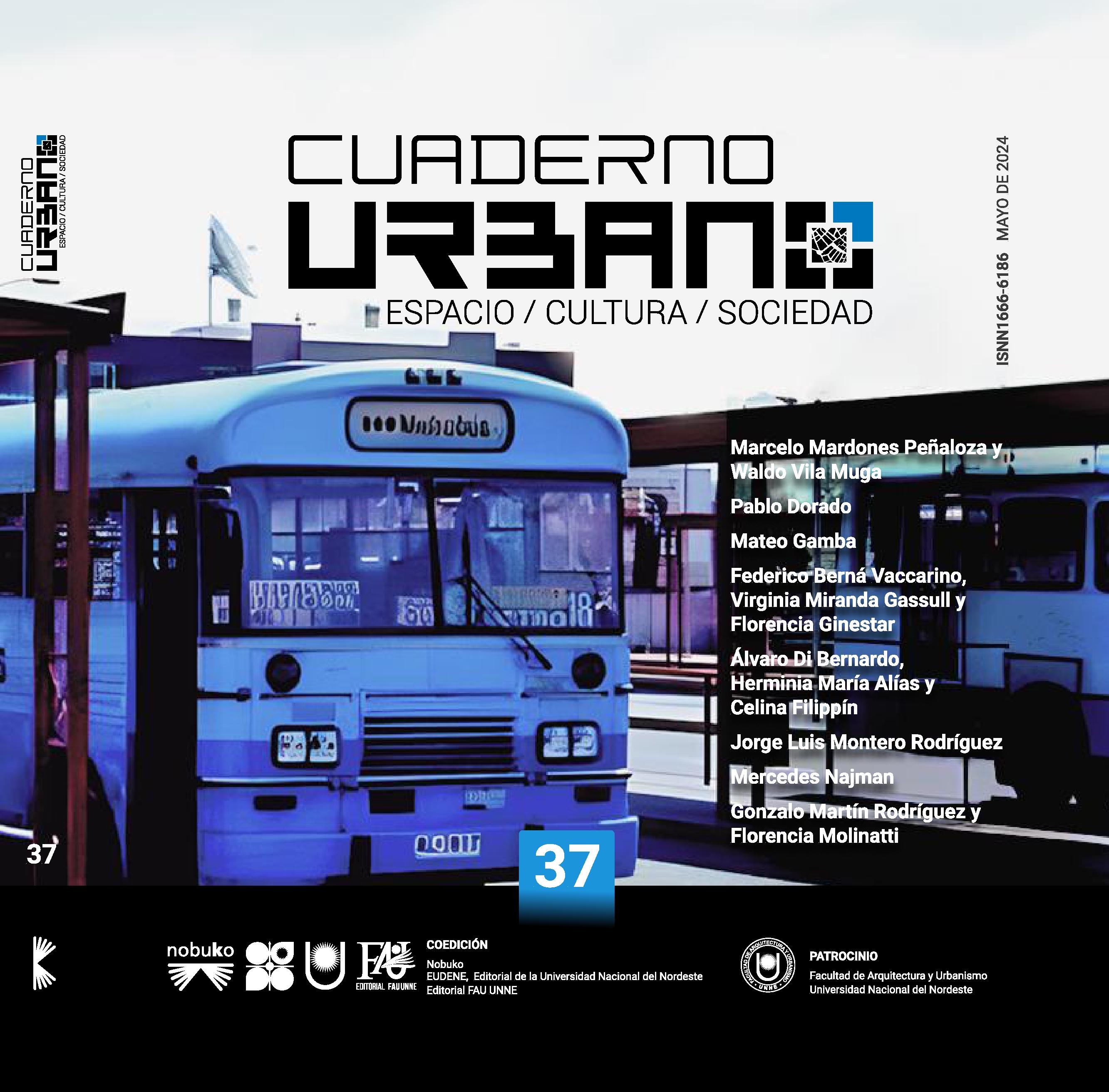ICT and the operacional transformation of space
DOI:
https://doi.org/10.30972/crn.37377518Keywords:
ICT, urban transformations, territorial restructuring, urban functions, land usesAbstract
Information and communication technologies have changed the way we carry out our activities in the city, giving rise to new spatial, location and mobility requirements for their development. Throughout this article, we inquire about the transformations that these technologies produce both in the functional organization of cities (system of actions), and in their physical-spatial conformation (systems of objects). By relating theoretical contributions from sociology, urban economics and geography, we raise questions regarding the way in which ICTs resignify the relationships between activities and material space. The work provides preliminary considerations for future research focused on the study of the distribution of functions in contemporary city and invites us to dabble into more complex and precise territorial readings of phenomena associated with ICTs such as e-commerce or teleworking.
Downloads
References
Anderson, C. (2008). The long tail: Why the future of business is selling less of more (Rev. and updated ed). Hyperion.
Ascher, F. (2007). Los nuevos principios del urbanismo: El fin de las ciudades no está a la orden del día. Alianza Editorial.
Brown, S. (1993). Retail location theory: Evolution and evaluation. The International Review of Retail, Distribution and Consumer Research, 3(2), 185-229. https://doi.org/10.1080/09593969300000014
Brueckner, J. K. (2011). Lectures on urban economics. MIT Press.
Carrión, F. (2020). La transformación de la comunicación local en tiempo de pandemia [ponencia]. IFAP- UNESCO. Brechas, deudas y logros: Lo que la pandemia revela sobre la Sociedad del Conocimiento en América Latina. https://www.youtube.com/watch?v=RNq-s8VTNzw&t=3537s&ab_channel=SOCINFOIIGG
Carrión, F., y Cepeda, P. C. (2022). La Teleciudad: “Del espacio de los lugares al espacio de los flujos”. En M. B. Odena, S. Finquelievich, & E. Estevez (Eds.), Fortaleciendo las Sociedades del Conocimiento en América Latina. Los desafíos y oportunidades de la pandemia y la postpandemia. https://drive.google.com/file/d/1oIdYGDQRpmtXPbC-IG5-fO21BzZiKcHV/view
Castells, M. (2001). La ciudad informacional: Tecnologías de la información, reestructuración económica y el proceso urbano-regional. Alianza Editorial.
Castells, M. (2006). La sociedad red: Una visión global (1a ed., 4a reimp). Alianza.
Cobo, C. (2019). El concepto de tecnologías de la información. Benchmarking sobre las definiciones de las TIC en la sociedad del conocimiento. Zer, 14(27), 295-318.
Comi, A., & Nuzzolo, A. (2016). Exploring the Relationships Between e-shopping Attitudes and Urban Freight Transport. Transportation Research Procedia, 12, 399-412. https://doi.org/10.1016/j.trpro.2016.02.075
Cortez Oviedo, P. S. (2020). Espacios públicos en el orden digital: El rol de las TIC en sus usos y apropiaciones sociales [Tesis Doctoral]. Faud - UNC.
Cortez Oviedo, P. S., y Finquelievich, S. (2021). Ciudad aumentada y pandemia El habitar en el Orden Digital. Cuaderno Urbano, 31(31). https://doi.org/10.30972/crn.31315784
Coster, D. (2019). The effects of online shopping on the retail real estate. [Tesis de Maestría, Faculty of TPM, Delft University of Technology]. https://repository.tudelft.nl/islandora/object/uuid:df927681-10ed-46cc-b43a-5ab600dda8cc?collection=education
Couclelis, H. (2000). From Sustainable Transportation to Sustainable Accessibility: Can We Avoid a New Tragedy of the Commons? En D. G. Janelle & D. C. Hodge (Eds.), Information, Place, and Cyberspace (pp. 341-356). Springer Berlin Heidelberg. https://doi.org/10.1007/978-3-662-04027-0_20
Couclelis, H. (2004). Pizza over the Internet: E-commerce, the fragmentation of activity and the tyranny of the region. Entrepreneurship & Regional Development, 16(1), 41-54. https://doi.org/10.1080/0898562042000205027
Couclelis, H. (2009). Rethinking Time Geography in the Information Age. Environment and Planning A: Economy and Space, 41(7), 1556-1575. https://doi.org/10.1068/a4151
Couclelis, H. (2021). Conceptualizing the City of the Information Age. En W. Shi, M. F. Goodchild, M. Batty, M.-P. Kwan, & A. Zhang (Eds.), Urban Informatics (pp. 133-145). Springer Singapore. https://doi.org/10.1007/978-981-15-8983-6_9
Erber, E., Georg, Klaus, P., y Voigt, U. (2001). E-Commerce Induced Change in Logistics and Transport Systems. Economic Bulletin, 38(10), 313-320. https://doi.org/10.1007/s10160-001-0109-y
Fabri, L., y Valverde Márquez, I. (2020). Will E-Commerce Dominate Physical Store? https://doi.org/10.5281/ZENODO.3894442
Finquelievich, S. (2016). I-Polis: Ciudades en la era de internet. Diseño.
Finquelievich, S., & Cortez Oviedo, P. S. (2022). Ciudad y mediatización urbana. Transformaciones y desafíos en la Córdoba de postpandemia.
Kantar. (2022). Los argentinos y el eCommerce ¿Cómo compramos y vendemos online? https://cace.org.ar/wp-content/uploads/2023/03/Estudio_Anual_2022_CACE_resumen.pdf
Mokhtarian, P. L. (2004). A conceptual analysis of the transportation impacts of B2C e-commerce. Transportation, 31(3), 257-284. https://doi.org/10.1023/B:PORT.0000025428.64128.d3
Moliní, F. (2002). Ventajas, inconvenientes e impactos territoriales del comercio electrónico. Investigaciones Geográficas, 27, 131. https://doi.org/10.14198/INGEO2002.27.04
Nahiduzzaman, K. M., Aldosary, A. S., & Mohammed, I. (2019). Framework Analysis of E-Commerce Induced Shift in the Spatial Structure of a City. Journal of Urban Planning and Development, 145(3), 04019006. https://doi.org/10.1061/(ASCE)UP.1943-5444.0000512
Nahiduzzaman, K. M., Holland, M., Sikder, S. K., Shaw, P., Hewage, K., & Sadiq, R. (2021). Urban Transformation Toward a Smart City: An E-Commerce–Induced Path-Dependent Analysis. Journal of Urban Planning and Development, 147(1), 04020060. https://doi.org/10.1061/(ASCE)UP.1943-5444.0000648
Ossokina, L., Teulings, C., y Sviták, J. (2018). The urban economics of retail.
Pettersson, F., Hiselius, L., y Koglin, T. (2016, julio 10). Exploring the nexus between e-commerce and urban land use planning – e-commerce impacts on mobility and location strategies. Paper presented at the 14th World Conference on Transport Research.
Santos, M. (2005). La naturaleza del espacio. Editorial Ariel. http://public.ebookcentral.proquest.com/choice/publicfullrecord.aspx?p=3159862
Schwab, K. (2017). La cuarta revolución industrial (1a ed. en Argentina bajo este sello). Debate.
Visser, E.-J., y Lanzendorf, M. (2004). Mobility and Accessibility Effects of B2c E-Commerce: A Literature Review. Tijdschrift Voor Economische En Sociale Geografie, 95(2), 189-205. https://doi.org/10.1111/j.0040-747X.2004.00300.x
Downloads
Published
Issue
Section
License

This work is licensed under a Creative Commons Attribution-NonCommercial-ShareAlike 4.0 International License.
CUADERNO URBANO sustains its commitment to the Open Access policies for scientific information, on account of the fact that both scientific publications and public funded research must circulate freely on the Internet and without restrictions.
CUADERNO URBANO ratifies the Open Access model in which the contents of scientific publications are available in full text free of charge on the Internet, without temporary embargoes, and whose editorial production costs are not transferred to the authors. This policy proposes breaking down the economic barriers that generate inequities both in access to information and in the publication of research results.





.jpg)








